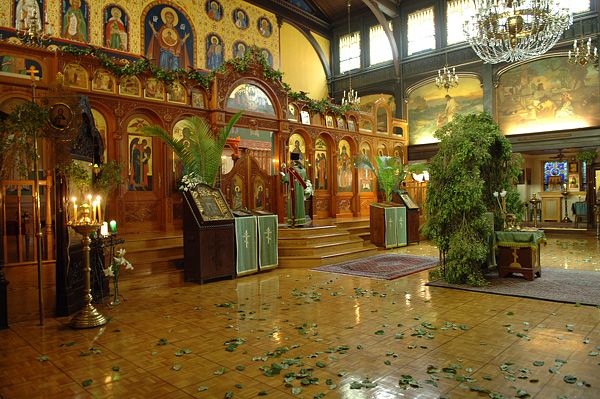 by Fr. Patrick Henry Reardon
by Fr. Patrick Henry Reardon
The fourth century introduced a significant change of perspective with respect to Pentecost, when the Council of Nicaea determined that the date of Pascha should always fall on the first Sunday of spring. Up to that point, a certain measure of local custom had prevailed, with some Christians—luminaries like Polycarp of Smyrna and Melito of Sardis—celebrating Pascha on the fourteenth day of the Jewish month of Nisan, no matter which day of the week.
However, everyone knew that the Lord rose from the dead on
“day-one of the week” (tei miai ton sabbaton) (Mark 16:1).
Each Sunday, then, virtually from the beginning, became the weekly occasion to celebrate the Lord’s Resurrection. It seemed perfectly logical to most Christians, consequently, to shift the annual celebration of Pascha, “the feast of Salvation” (as the Church historian Socrates called it) to a Sunday, making it the chief Sunday of the year and thus strengthening the theme of the Resurrection. Most Christians had adopted this practice by the second century, and in 325 the Nicene Council codified this practice for the whole Church.
In turn the council, by this decision, necessarily established a Sunday as the time to celebrate the final day of Pentecost. Thus, in Christian thought and experience the Holy Spirit’s descent on the Church became more closely tied to the theological themes associated with the weekly “Lord’s Day,” the kyriake hemera (Revelation 1:10).
Because the Nicene Council also assigned to the church at Alexandria the task of calculating the correct date of Pascha each year, Athanasius, who became the bishop of that city just three years later, inherited that responsibility. He used those annual Paschal Letters to the churches as opportunities to strengthen the authority of the Nicene Creed and to elaborate this new perspective on Pentecost.
Athanasius reasoned that, since seven is the number of perfection, the days of Pentecost signify perfection multiplied by itself; it was the fullness of the Sunday of Pascha, “the great Sunday.” Pascha/Pentecost was a “holy day” of seven weeks. Indeed, he wrote, it was of this entire period of seven weeks that the Psalmist declared,
“This is the day which the Lord has made.”
We pass through that season, consequently,
“as through a succession of feasts, keeping the festival to the Spirit, Who is even now near us in Jesus Christ.”
Because Pentecost is the fullness of the Pascha, and the resurrected life is our eternal destiny, Athanasius saw in the season of Pentecost an icon of eternity. For the Pascha of 332 he wrote,
“Let us celebrate also the days of holy Pentecost, demonstrating through them the world to come.”
To the Sunday of Pascha are joined
“the seven weeks of Pentecost, with prayers, and fellowship with our neighbor, and love towards one another, and that sense of peace, which is over everything.”
Pascha “extends its rays, with translucent grace, to all the seven weeks of the holy Pentecost.” When Athanasius said we are to
“keep the holy feast of Pentecost,”
he had all seven weeks in mind.
Saint Basil, in his treatise on the Holy Spirit, written about 375 (two years after the death of Athanasius), further explored the relationship of Pentecost to the Resurrection. Beginning and ending on a Sunday, the day the Lord rose from the dead, Pentecost is full of the Resurrection and serves as an icon of eternity.
Basil wrote,
“The whole period of fifty days (pentecoste) causes us to remember the resurrection expected in the world to come. For that one and first day, if seven is multiplied by seven, completes the seven weeks of the holy Pentecost; for, beginning on the first day, Pentecost also ends on the first day, making fifty revolutions through the like intervening days. And so it is a likeness of eternity, inasmuch as it begins and ends, as through a circling movement, at the same point.”
